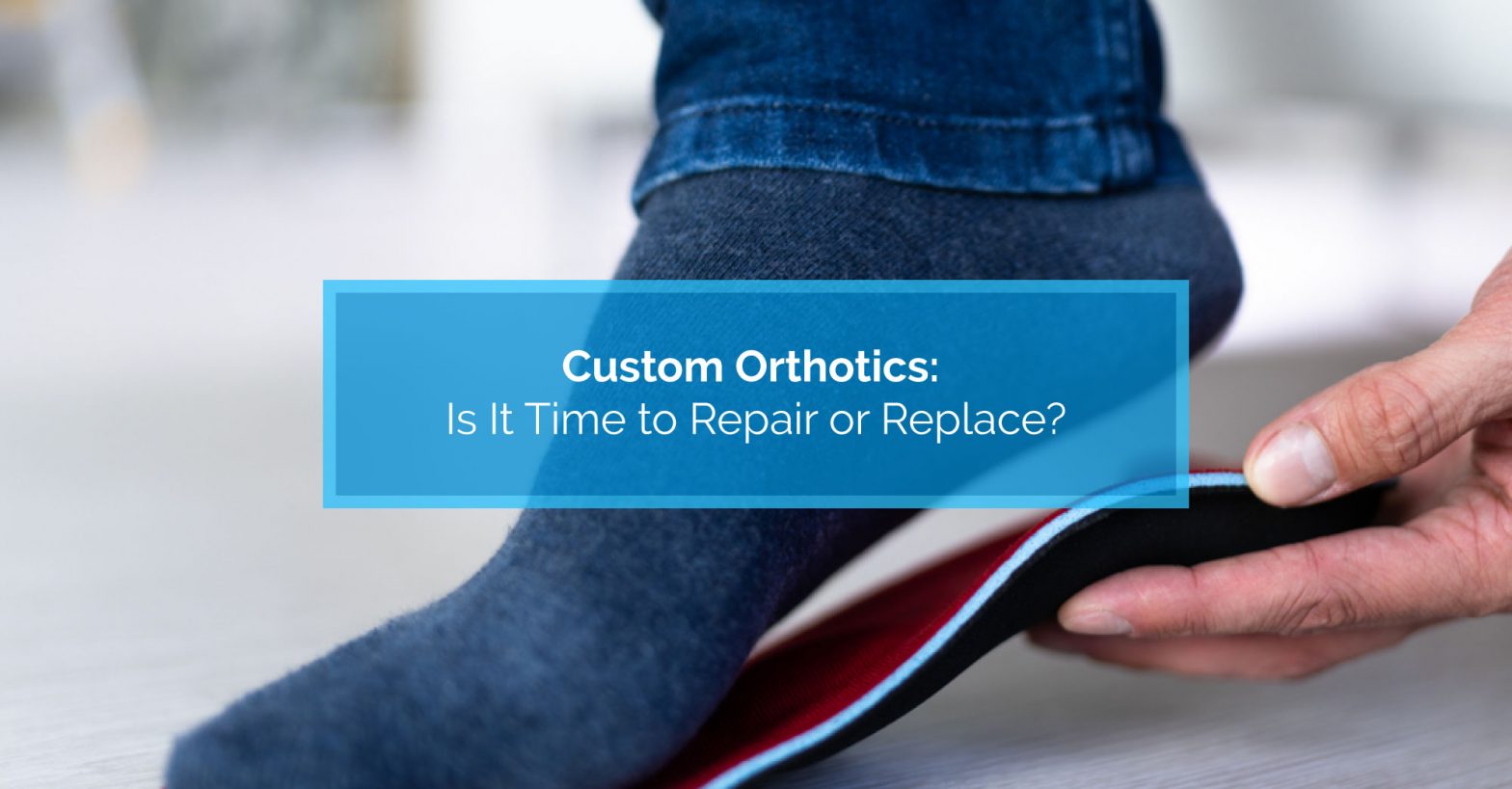Osteoarthritis Treatments: What You Need to Know...
Key Highlights: Osteoarthritis treatments focus on pain relief, restoring joint…
Read More
Posted by Dr. Scott Wilson | 01-Sep-2023
Custom orthotics can be a lifesaver for those who suffer from foot pain or discomfort. They’re designed to provide support and effective foot pain relief by correcting foot alignment, foot mechanics and distributing pressure evenly. However, like any other medical device, custom orthotics can break down over time, leading to discomfort and reduced effectiveness. In this article, we’ll explore how custom foot orthotics work and why they break down. We will also discuss how you can recognize when repair or replacement is needed. If you’re experiencing pain or discomfort while wearing your custom orthotics, here’s what you need to know.
Custom orthotics are tailor made shoe inserts that provide relief from pain and discomfort by correcting biomechanical abnormalities, improving foot alignment, and gait mechanics. They correct biomechanical abnormalities and provide orthopedic support, reposition your feet for optimal alignment, distribute your body weight evenly and reduce pressure. With padding and softer materials, they also provide a cushion against shock & impact, relieve heel pain, and reduce calluses. Because of how they correct alignment issues, improve foot function, and distribute pressure evenly, custom orthotics can provide relief from conditions like plantar fasciitis and arthritis, while also offering additional cushioning and support for flat feet.
Custom orthotics can break down and lose effectiveness due to regular wear and tear, and changes in your foot structure, gait mechanics or body weight. Wear and tear shows as thinning or cracking of materials, loss of shape and alignment, and visible signs of degradation. This can be impacted by the intensity of use and by inadequate care and maintenance. Changes in foot structure, such as flat feet or high arches, can also impact their effectiveness. Aging and certain medical conditions can also cause shifts in your foot alignment and shape. Changes in your foot structure may necessitate either repair or replacement of your orthotics. Your Chiropodist can help determine if these changes warrant new orthotics.
Visible signs of wear, such as cracks, tears, or excessive thinning is one way to identify a need for repair or replacement. Cracks, tears, and thinning of materials significantly undermines the effectiveness of your orthotics and their ability to provide the intended support, correction, and comfort your feet require. Specifically, they can indicate a decline in structural integrity, the ability to evenly distribute pressure, provide arch support and cushioning, and the ability to correct gait mechanics and proper foot functioning.
Feeling increased discomfort while wearing your custom orthotics is a clear signal that they may need repair or replacement. As your orthotics deteriorate, their ability to offer effective support and in relief diminishes. Increased pain and discomfort may because by a breakdown in the corrective capabilities of your orthotics. If misalignment is and improper foot movement is allowed, this instability during movement can lead to discomfort, especially during activities that require balance. Uneven surfaces formed by deterioration can also create pressure points on your feet, disrupting the even distribution of your weight and leading to pain and discomfort. Impact absorption, another key function, might also be compromised, resulting in increased impact on your joints and muscles and increased pain and discomfort.
Uneven wear patterns developing on your shoes is a clear indication that your custom orthotics may need repair or replacement. As your orthotics deteriorate, their ability to provide proper support and alignment diminishes, leading to these uneven patterns. The areas of your orthotics that have worn down unevenly can no longer effectively distribute your weight or maintain the correct foot mechanics. This imbalance in pressure and alignment can translate into uneven wear on your shoes. The orthotics’ primary purpose is to ensure that your weight is evenly distributed and that your foot mechanics remain aligned during movement. When this balance is disrupted due to the deterioration of your orthotics or a change in your foot mechanics, it’s reflected in the wear patterns on your shoes.
Changes in the structure of your feet or alterations in your gait mechanics directly impact how your orthotics function. They’re another clear signal that your custom orthotics may need to be repaired or replaced. Our feet change due to a variety of factors including weight fluctuations, aging, or pregnancy. If your feet have changed, your orthotics might no longer align with your current foot structure. This compromises their ability to provide effective support and correction. Similarly, shifts in your gait mechanics, such as overpronation or supination, can result in uneven pressure distribution on your orthotics, leading to uneven wear and diminished support. Because your custom orthotics are tailored to address specific foot mechanics, when these mechanics change, the orthotics might no longer be aligned with your particular needs. This misalignment can not only lead to discomfort and pain but also exacerbate conditions your orthotics were designed to address.
It can be hard to determine whether your custom orthotics require repair or replacement. If you’re unsure, you should speak with your Chiropodist, Chiropractor or orthotics specialist. They can assess the condition of your orthotics, re-evaluate your needs including any changes to the structure of your feet and your gait mechanics, and provide guidance on the best course of action.
Repairing your custom orthotics is a viable option for addressing minor damage. This includes small cracks or tears, where the overall structure remains intact. Typically, this involves fixing damaged cushioning, reattaching layers that have separated, and reinforcing weakened areas. It may also involve replacing components or adding cushioning. Foam, graphite, and softer materials can be used. Gait mechanics and foot alignment will be considered during the process. If your orthotics have become less supportive or uncomfortable due to damage, a skilled orthotics expert can evaluate the issue and recommend appropriate repairs. Replacing worn-out top covers can enhance comfort and support. Additionally, if there have been minor changes in the structure of your feet or in your gait mechanics, adjustments can be made to restore the corrective functioning of your orthotics. Ultimately, repairing custom orthotics addresses specific damages and issues, offering a cost-effective alternative to replacement.
Replacing rather than repairing your custom orthotics becomes necessary when wear and tear has significantly compromised their overall functionality. Orthotics that exhibit extensive cracks, tears, or thinning materials, especially across larger surface areas, might be beyond repair. Issues such as flattened cushioning or alterations in arch support can compromise the corrective capabilities of your custom orthotics. Additionally, if there have been more significant changes in the structure of your feet or in your gait mechanics due to factors like weight change or aging, simple adjustments might not be enough. The key is to ensure that you continue to receive the necessary support, correction, and relief you need.
Custom orthotics typically last anywhere from 1 to 5 years, depending on usage and care. Look for signs like wear and tear, discomfort or pain, or changes in foot structure. Regularly cleaning and maintaining your orthotics can extend their lifespan. Consult with your Chiropodist or orthotics specialist if you’re unsure about repair or replacement.
Proper care is essential for maintaining the longevity of your custom orthotics. Follow the specific care instructions provided by your orthotics provider. This includes avoiding extreme heat or moisture, selecting proper footwear, and considering multiple pairs for different activities. You should also have them reassessed every 1-2 years.
Yes, it’s often possible to modify or adjust, rather than replace your custom orthotics. Your Chiropodist or orthotics specialist can assess their condition and make necessary modifications. This might include adding padding or adjusting the heel cup angle, to ensure proper fit and function.
Custom orthotics are an investment in your health and overall well-being. Recognizing signs that indicate the need for repair or replacement, understanding the reasons behind wear and tear, and making the right decision regarding repair vs replacement is essential for ensuring that this investment continues to pay dividends. If you’re unsure about whether repair or replacement is required, your Chiropodist, Chiropractor or custom orthotics specialist can provide the necessary guidance and support.
If your custom orthotics are more than a year old or if you’re experiencing increased pain or discomfort, we can help. Contact us today and let us show you why, at Physiomed…Healthier Starts Here.

Key Highlights: Osteoarthritis treatments focus on pain relief, restoring joint…
Read More
Key Highlights: Runner's knee, or patellofemoral pain syndrome, is a…
Read More
Key Highlights: Upper back and neck pain can be caused…
Read More
Key Highlights: Many people want to lose belly fat for…
Read More
Key Highlights: Vestibular physical therapy, or physiotherapy, is a specialized…
Read More
Key Highlights: Tennis elbow, or lateral epicondylitis, is a condition…
Read More